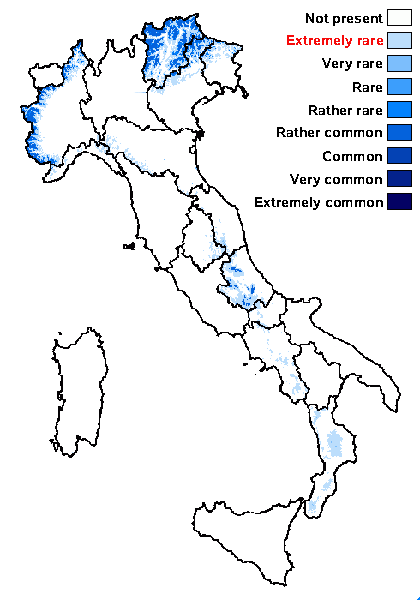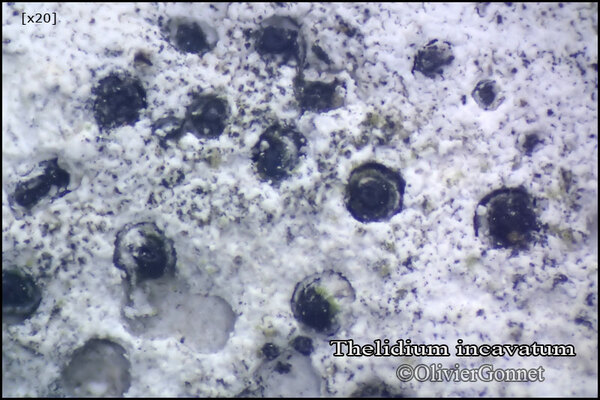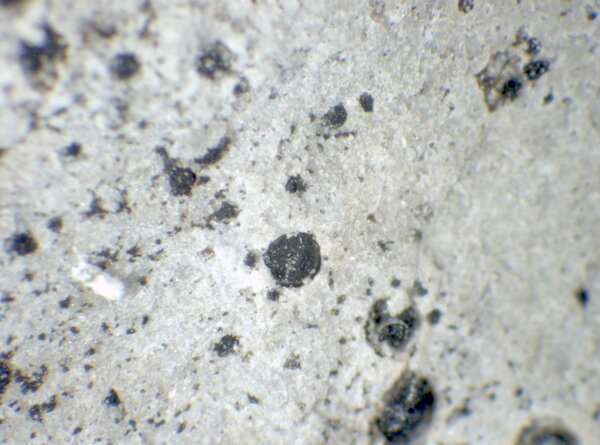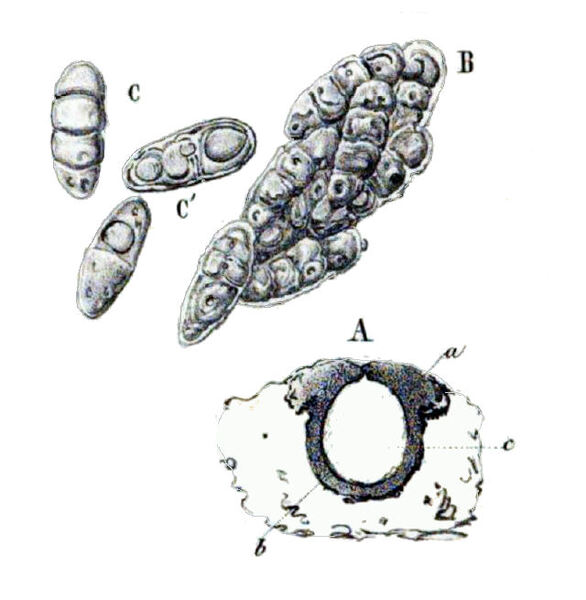Thelidium incavatum Mudd
Nyl. ex Mudd, Man. Brit. Lich.: 295, 1861.
Synonyms: Amphoridium umbrosum A. Massal.; Amphoroblastia incavata (Mudd) Servít; Polyblastia incavata (Mudd) Croz.; Thelidium umbrosum (A. Massal.) A. Massal. non Arnold; Verrucaria cryptarum var. asperata Garov.
Distribution: N - Frl (Breuss 2008), Ven (Lazzarin 2000, Nascimbene 2008c), TAA, Piem (TSB 33967), Emil (Tretiach & al. 2008, Fariselli & al. 2020), Lig. C - Marc (Herb. Ravera 3541), Umb (Genovesi & Ravera 2001, Ravera & al. 2006), Abr (Cucchi & al. 2009, Gheza & al. 2021), Mol (Nimis & Tretiach 1999, Caporale & al. 2008). S - Camp (Aprile & al. 2003b), Cal (Puntillo 1996).
Description: Thallus crustose, endosubstratic to hemiendosubstratic, up to 0.1-0.15 mm thick, whitish, dirty cream-coloured or pale grey, continuous or finely cracked, sometimes poorly evident. Perithecia black, often pear-shaped, 0.2-0.5(-0.6) mm across, immersed in the rock, with the upper part slightly projecting, often separated from the rock by a fine fissure, leaving deep pits when they fall out. Involucrellum absent or poorly developed, apical, 30-60(-90)μm thick; exciple dark brown to black throughout, 15-25 μm thick, (170-)260-520(-660) μm across; hamathecium of periphyses and periphysoids measuring c. 40-50 x 1.5-2 μm, interascal filaments absent; hymenial gel I+ red (I+ blue at very low concentrations of I), K/I+ blue. Asci 8-spored, ellipsoid to clavate, I-, fissitunicate, the wall thickened above, with an ocular chamber, dehiscent by extrusion of a delicate rostrum. Ascospores 3(-5)-septate, rarely submuriform with 1(-2) longitudinal septa, hyaline, narrowly ellipsoid, (25-)32-46(-60) x (9-)12-16(-20) μm. Photobiont chlorococcoid. Spot tests: K-, C-, KC-, P-, UV-. Chemistry: without lichen substances.Note: on small calcareous pebbles close to the ground, usually in upland areas; probably more widespread, but overlooked. According to Breuss (2014) T. umbrosum is perhaps an independent species.
Growth form: Crustose
Substrata: rocks
Photobiont: green algae other than Trentepohlia
Reproductive strategy: mainly sexual
Commonnes-rarity: (info)
Alpine belt: rather common
Subalpine belt: rather rare
Oromediterranean belt: very rare
Montane belt: extremely rare
Submediterranean belt: absent
Padanian area: absent
Humid submediterranean belt: absent
Humid mediterranean belt: absent
Dry mediterranean belt: absent

Predictive model
Herbarium samples

Courtesy Danièle et Olivier Gonnet - Source: https://www.afl-lichenologie.fr/Photos_AFL/Photos_AFL_T/Textes_T2/Thelidium_incavatum.htm
France, 25/8/2016 - Crête du Mont d'Or, alt. 1450 m - Doubs

Courtesy Danièle et Olivier Gonnet - Source: https://www.afl-lichenologie.fr/Photos_AFL/Photos_AFL_T/Textes_T2/Thelidium_incavatum.htm
France, 25/8/2016 - Crête du Mont d'Or, alt. 1450 m - Doubs

Courtesy Danièle et Olivier Gonnet - Source: https://www.afl-lichenologie.fr/Photos_AFL/Photos_AFL_T/Textes_T2/Thelidium_incavatum.htm
France, 25/8/2016 - Crête du Mont d'Or, alt. 1450 m - Doubs


P.L. Nimis; Owner: Department of Life Sciences, University of Trieste
Herbarium: TSB (34785)
2002/02/02

Source: Zschacke, H. (1934) Epigloeaceae, Verrucariaceae und Dermatocarpaceae. In: Dr. L. Rabenhorst‘s Kryptogamen-Flora, Band 9, Abt. 1, Teil 1. Akademische Verlagsgesellschaft, Leipzig, 695 pp. - Public Domain
Growth form: Crustose
Substrata: rocks
Photobiont: green algae other than Trentepohlia
Reproductive strategy: mainly sexual
Commonnes-rarity: (info)
Alpine belt: rather common
Subalpine belt: rather rare
Oromediterranean belt: very rare
Montane belt: extremely rare
Submediterranean belt: absent
Padanian area: absent
Humid submediterranean belt: absent
Humid mediterranean belt: absent
Dry mediterranean belt: absent

Predictive model
| Herbarium samples |

Courtesy Danièle et Olivier Gonnet - Source: https://www.afl-lichenologie.fr/Photos_AFL/Photos_AFL_T/Textes_T2/Thelidium_incavatum.htm
France, 25/8/2016 - Crête du Mont d'Or, alt. 1450 m - Doubs

Courtesy Danièle et Olivier Gonnet - Source: https://www.afl-lichenologie.fr/Photos_AFL/Photos_AFL_T/Textes_T2/Thelidium_incavatum.htm
France, 25/8/2016 - Crête du Mont d'Or, alt. 1450 m - Doubs

Courtesy Danièle et Olivier Gonnet - Source: https://www.afl-lichenologie.fr/Photos_AFL/Photos_AFL_T/Textes_T2/Thelidium_incavatum.htm
France, 25/8/2016 - Crête du Mont d'Or, alt. 1450 m - Doubs


P.L. Nimis; Owner: Department of Life Sciences, University of Trieste
Herbarium: TSB (34785)
2002/02/02

 DOLICHENS
DOLICHENS



